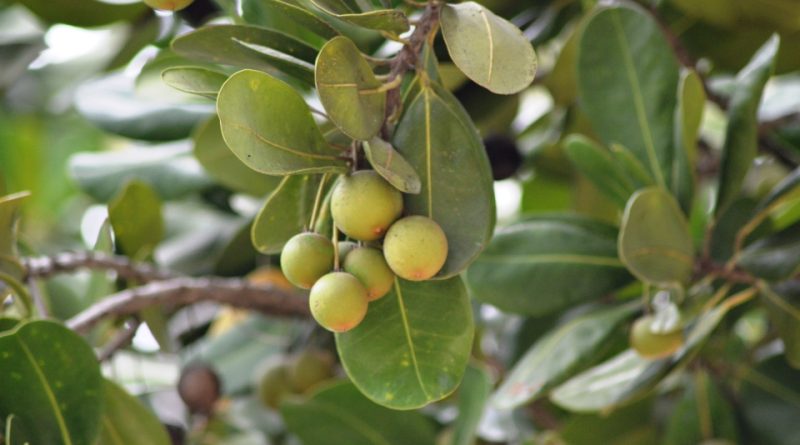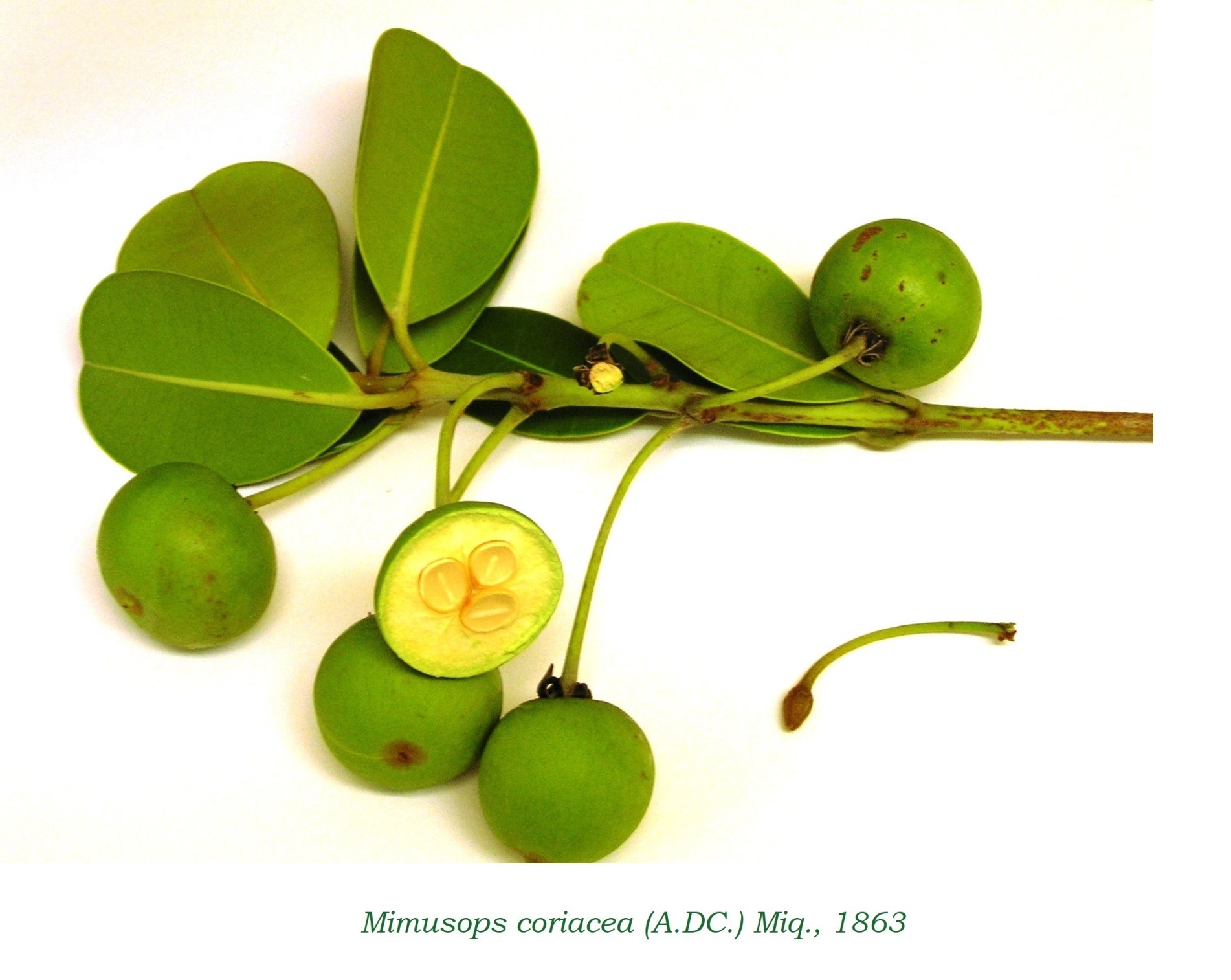Mimusops coriacea
Mimusops coriacea
The Mimusop (Mimusops coriacea (A.DC.) Miq., 1863) is an arboreal species belonging to the Sapotaceae family.
Systematics –
From a systematic point of view it belongs to:
Eukaryota domain,
Kingdom Plantae,
Magnoliophyta division,
Class Magnoliopsida,
Ebenales Order,
Sapotaceae family,
Genus Mimusops.
The term is basionym:
– Imbricaria coriacea A.DC..
The terms are synonyms:
– Imbricaria coriacea var. longifolia Lecomte;
– Mimusops dissecta Buch.-Ham.;
– Mimusops dissecta Buch.-Ham. ex A.DC.;
– Mimusops hexandra Bouton;
– Mimusops hexandra Bouton ex Bojer;
– Phlebolithis indica Gaertn..
Etymology –
The term Mimusops is the combination of the Greek substantive “μῖμος”, mimos, i.e. imitator, mime, monkey and “ὄψις”, opsis, i.e. aspect, with reference to the shape of the flower.
The specific leathery epithet comes from from córium leather: leathery, leathery, in reference to the consistency of the leaves.
Geographic Distribution and Habitat –
Mimusops coriacea is a plant native to Madagascar and the Comoros Islands, where it grows along the entire eastern coast and also, for a short distance, in the north-western one.
Its habitat is that of the dunes and of the coastal forests on sandy soils, from the sea level up to about 150 m of altitude, in areas characterized by a high rainfall and a little marked dry season.
Description –
Mimusops coriacea is an evergreen plant, which grows in the form of a shrub or tree, up to about 15 meters in height and more and with abundant foliage.
The bark is gray-brown, which tends to fissure vertically with age, and with milky sap.
The leaves are usually grouped at the apex of the branches on a 1-1,5 cm long petiole; they are alternate, simple, elliptical to obovate in shape with emarginated apex and entire margin; they are 7-16 cm long and 5-8 cm broad, of a leathery consistency, of a dark green color and glossy above, paler below.
The flowers are supported by a 4-6 cm long pedicel; they are in the axillary position, solitary or fasciculate, of about 1.5 cm in diameter; they are whitish in colour, with a calyx made up of 8 sepals arranged in 2 whorls of 4, triangular, the exteriors not superimposed, the interiors imbricated, about 0.5 cm long, covered externally by a reddish-brown tomentum. The corolla is characterized by a short tube and 8 lobes which are deeply incised in thin segments; it has 8 stamens alternating with 8 staminoids and a pubescent ovary with 8 loculi.
The fruits are globular shaped berries, of 3-5 cm of diameter; they have a green color at the beginning and then become yellow or orange when ripe.
Inside there are 1-3 ellipsoid seeds, laterally compressed, dark brown and shiny.
Cultivation –
Mimusops coriacea is a plant that grows as a shrub, up to 6 meters tall when growing on dunes near the sea, but becomes a tree up to 20 meters tall in coastal forests.
The fruit is edible and is harvested from the wild for local consumption. The tree is often planted in tropical America and in botanical gardens.
In fact, due to its ornamental characteristics, resistance to wind and marine climate, it has been introduced in many tropical and subtropical countries as windbreak and shade in areas close to the sea, where in some cases it has escaped cultivation by naturalizing and behaving at times as a weed, in particular it has become part of the landscape of the coasts of Brazil.
For its cultivation it requires full sun and adapts to different types of soil, provided draining, and even if it prefers humid climates with a limited dry season, when adult it can resist periods of drought.
Propagation is generally by seed.
Customs and Traditions –
Mimusops coriacea is a plant known by various names, including: monkey’s apple and Mimusops (English); abricó, abricoteiro, abricó-da-praia, abricó-do-mato, maracujá-de-árvore (Brazil); kagnarou (Comoros); canistel japones (Cuba); pomme d’accot (La Réunion); anganahara, voranto (Madagascar); pomme jacquot, pomme jacot, pomme jako (Mauritius).
It is a plant cultivated in many countries of the world where it grows on sand in coastal vegetation.
It has edible but not very popular fruits, with a floury and slightly sticky pulp.
The seeds, particularly hard, are used by local crafts for necklaces and other costume jewellery, the wood is of good quality and various parts of the plant show medicinal virtues.
Furthermore, an oil is extracted from the seeds which is used in painting.
The good quality wood has a limited use in civil and naval construction and in cabinet making.
Various parts of the plant are used in popular medicine for various pathologies.
Method of Preparation –
Mimusops coriacea is one of the plants that are used for both food and medicinal purposes.
The fruits are edible raw; they have a sweet and floury pulp but they are not very popular.
In the medicinal field it was used, above all in the past, for various purposes and pathologies.
Guido Bissanti
Sources
– Acta Plantarum – Flora of the Italian Regions.
– Wikipedia, the free encyclopedia.
– GBIF, the Global Biodiversity Information Facility.
– Useful Tropical Plants Database.
– Conti F., Abbate G., Alessandrini A., Blasi C. (ed.), 2005. An annotated checklist of the Italian vascular flora, Palombi Editore.
– Pignatti S., 1982. Flora of Italy, Edagricole, Bologna.
– Treben M., 2000. Health from the Lord’s Pharmacy, Advice and experiences with medicinal herbs, Ennsthaler Editore.
Photo source:
– https://inaturalist-open-data.s3.amazonaws.com/photos/154053201/original.jpeg
– https://www.fnai.org/species-communities/invasives/invasive-species?ID=108
Attention: The pharmaceutical applications and alimurgical uses are indicated for informational purposes only, they do not in any way represent a medical prescription; we therefore decline all responsibility for their use for curative, aesthetic or food purposes.


